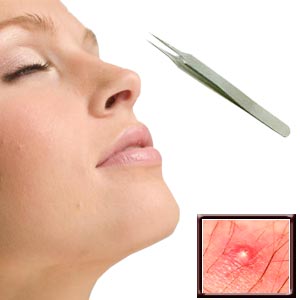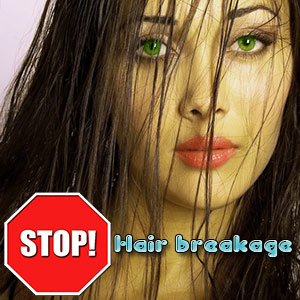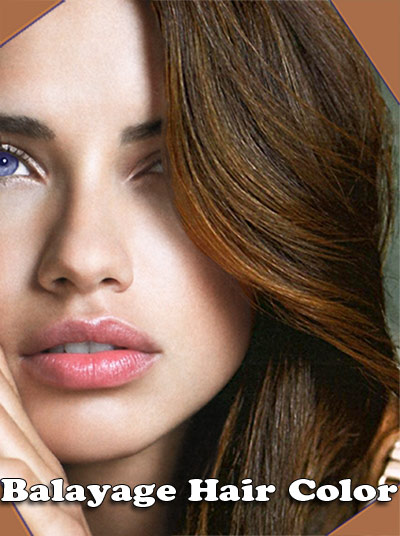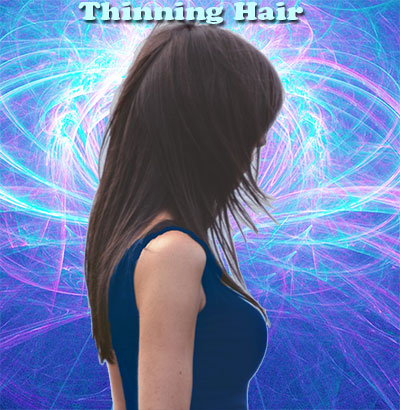Ingrown Hair

What is ingrown hair? Are you sure that you do not have ingrown hair? What are the problems related to ingrown hair growth? What are the options for ingrown hair removal? Read up to find out how to treat ingrown hair.
Ingrown Hair
All is well when you allow the hair to grow naturally without tampering. As you set to remove unwanted hair growth on the face, legs or anywhere in close contact with the skin, it means curtailing or tampering natural growth system of hair. Waxing, tweezing, depilation or shaving unwanted hair might result in removing hair below the level of the skin. The hair ends are left with pointed tip.
When the hair tip begins to re-grow, it grows within the surrounding tissue instead of growing outward. As a result, the hair curls back or grows sideways into the skin. This is termed as ingrown hair. Ingrown hair irritates the skin to a great extent. This condition is often accompanied by an infection, redness and swelling at the hair follicle.
The medical term for ingrown hair is pseudofolliculitis barbae or PFB. Ingrown hair problems are common with people who have thick, curly-hair. However, it can affect anyone including people with straight hair. Friction resulting from tight clothing or belts is understood to be another reason for ingrown hair. Most ingrown hairs occur in the beard area for men. Women notice ingrown hair on the legs, underarms and pubic area.
Recognizing ingrown hair
It is the skin that reacts to ingrown hair, which is easily identifiable. An inflammation in the form of tiny red bumps start appearing around the affected site. However, the symptoms differ from person to person. Often symptoms of ingrown hair may resemble other skin infections. Ingrown hair may be sometimes seen beneath the inflamed skin. Ingrown hair is worsened by acne or bacterial or fungal infections. Exfoliating your skin can help keep ingrown hair at bay.
- Redness, tenderness And swelling followed by pus formation
- Bleeding in infected area
- Itching, Tingling sensation
- Mild or severe pain on the affected area
- Scars in chronic cases.
Ingrown hair removal
You can minimize ingrown hair problems by reducing friction, particularly close to the affected area. Following a healthy skin regime, as simple as washing the area before hair removal keeps the skin supple. Choosing and adopting skin friendly hair removal methods can keep problems at bay. Ingrown hair left as it is, heals on its own. Treatment options are available to treat chronic ingrown hair.
- Allow the hair to grow longer to help it come out straight
- Choose special razors that do not cut super-close
- Consciously shave in a different direction
- Use topical antiseptics
- Use antibiotics in case of an infection
- Opt for permanent hair removal for persistent problem. Electrolysis or laser hair removal can help in extreme
Stop shaving: It is best to let your hair grow out for a while. Rest your skin for a minimum of three days and allow the hair to grow a little longer. This prevents the hair from growing back into the skin. Once the hair gets to a certain length, select a razor that does not shave too close to the skin. Avoid using a double or triple-edged razor. Try using an electric razor or clipper that leaves some hair on the skin surface.
Use antibiotics: A topical antibiotic cream or solution that is suitable for your skin type can be effective in controlling ingrown hair problem. You can also enjoy twin benefits by choosing an anti-inflammatory coupled with antiseptic treatment method. This fights germs, bacteria found on the skin and guards from swelling and inflammation of the tissue.
Use humectants, conditioners: Humectants work towards moisturizing your skin. Use of humectants is an effective treatment option for ingrown hair as it controls excessive drying of the skin. Liberal use of conditioner helps in retaining a soft skin. Humectants and conditioners greatly reduce the possibility of hair tips from growing into the skin.
Pamper with lotion: Select a lotion, cream or gel suitable for your skin type that can pamper skin after a rigorous hair removing procedure. Best treatment option should work towards prevention of razor bumps as well as treat ingrown hair problems.
Laser hair removal: For a permanent ingrown hair treatment, selecting a laser treatment can be ideal. Home laser treatment is not only painless; it is affordable and effective too. Laser hair removal works by reducing the cell's ability to produce hair. Concentrated laser light destroy particular hair follicle. The skin is not affected in any way as the laser light targets only the hair.
Electrolysis hair removal: A device called epilator with short-wave radio frequency provides permanent treatment option for ingrown hair problem. The epilator is inserted into the hair follicle, which destroys the growth of follicle cells.
Ingrown hair treatment
- Do not meddle or squeeze the infected area.
- Use alcohol or toner to disinfect the area.
- Keep aside a clean towel dipped in boiling water.
- Allow the towel to cool. Gently pat on the infected area.
- Repeat step 1-4 several times.
- The hair rises to the surface of the skin.
- You can tweeze out this hair.
Top of the Page: Ingrown Hair
Tags:#ingrown hair #ingrown hair removal #ingrown hair treatment
 Hair Loss
Hair Loss Thinning Hair Remedies
Stop Hair Breakage
Damaged Hair Care
Scalp Psoriasis
Hair Loss Treatment and Hair Restoration
Female Hair Loss
Menopause and hair loss
Pattern Baldness in Women
Hair Weaving
Hair Frizz
Ingrown Hair
Hair Care in Winter
Hair Masque
Hair Detanglers
Hair Color
 Covering Grays
Covering Grays Balayage Hair Color
Blonde Hair Long
Red Hair Color
Brunette Hair Color
Hair Highlighting
Eclipting Hair Color
Different HairStyles
 Easy Hair Style
Easy Hair Style Virtual Hairstyle
Punk Hairstyle
Celebrity Hairstyle
Asian Hairstyle
Interactive Hair Style Gallery
Messy Side Braiding
Braid Hair Style
Updo Hair Style
Kid Hair Style
Bob Hairstyle
Hair Perm
Hairstyles for Long Hair
Curly Hair Style
Medium Length Hairstyles
Hair style Tips
 Hair Parting Tips
Hair Parting Tips Hairstyles to look Younger
Washing Hair
Faster Hair Growth
Hair Makeover
Curling Iron
Hair Accessory
Laser Hair Brush
Hair Gel
Hair Transplant
Hair Extension
Hair Mousse and Hairspray
Blow Drying
Hair Dryer
Cysteine Hair Treatment
Hair Straightening
Laser Hair Removal
Human Hair Wig
Dandruff Shampoo
Top of the Page: Ingrown Hair
Popularity Index: 101,171

